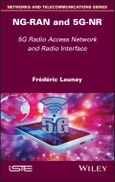This book describes the architecture of the NG radio access network and the 5G-NR radio interface according to the 3GPP (3rd Generation Partnership Project) specifications. The overall architecture of the NG-RAN, including the NG, Xn and F1 interfaces and their interaction with the radio interface, are also described. The 5G-NR physical layer is mainly connected by implementing antennas, which improves transmission capacity. 5G-SA deals with the 5G Core network.
In the 5G-SA model, the mobile is attached to the 5G Core network through NG-RAN. The book explains radio procedure, from switching on a device to establishing a data connection, and how this connection is maintained even if mobility is involved for both 5G-SA and 5G-NSA deployment. NG-RAN and 5G-NR is devoted to the radio access network, but mobile registration, establishment procedures and re-establishment procedures are also explained.
Table of Contents
Preface xi
Chapter 1. NG-RAN Network - Functional Architecture 1
1.1. Functional architecture NSA/SA 1
1.1.1. Option 3 4
1.1.2. Option 4 5
1.1.3. Option 7 6
1.2. Description of the NG-RAN network 7
1.2.1. The NG-RAN 8
1.2.2. AMF (Access management and Mobility Function) 10
1.2.3. SMF (Session Management Function) 11
1.2.4. UPF (User Plane Function) 12
1.3. Functional separation between the NG-RAN radio interface and the 5G core network 13
1.3.1. Mobile identities 13
1.3.2. Mobile mobility 17
1.4. Scheduling and QoS 19
1.4.1. Scheduling 19
1.4.2. Support for quality of service on radio link 21
1.5. Security architecture 24
1.6. Network slicing 26
1.7. References 28
Chapter 2. NG-RAN Network - Protocol Architecture 31
2.1. The protocol architecture of the radio interface 31
2.1.1. Protocol stack on the Uu interface 32
2.1.2. The protocol architecture on the Xn interface 35
2.1.3. Protocol architecture on the F1 interface 37
2.1.4. Protocol stack on the NG interface 42
2.2. Procedures on the radio network access 45
2.2.1. XnAP procedures 45
2.2.2. F1 interface procedures 48
2.2.3. NG-AP procedures 50
2.3. Identities of the XnAP and NG-AP application protocols 56
2.4. References 56
Chapter 3. NG-RAN Network - Procedures 59
3.1. General procedure of the 5G-NSA mode 59
3.1.1. LTE search procedure 60
3.1.2. Random access procedure 62
3.1.3. Data transfer 65
3.1.4. Removing a secondary node 70
3.2. General procedures of the 5G-SA 71
3.2.1. Initial random access and beam management procedure 71
3.2.2. Establishment of radio connection 74
3.2.3. Register request 75
3.2.4. The procedure for establishing a PDU session 84
3.3. References 87
Chapter 4. 5G-NR Radio Interface - The Physical Layer 89
4.1. 5G-NR radio interface 89
4.1.1. OFDM waveform 89
4.1.2. Frequency bands and multiplexing methods 90
4.1.3. NR frame structure 93
4.1.4. NR frame structure in the time domain 94
4.2. TDD mode configurations 96
4.2.1. Static configuration per cell 96
4.2.2. Specific TDD configuration 98
4.2.3. The dynamic configuration of the transmission for a group of mobiles 98
4.3. Physical resource 98
4.3.1. Resource grid 98
4.3.2. Resource bloc and bandwidth part 100
4.4. Physical channels and physical signals 101
4.4.1. Physical signals and reference signals 101
4.4.2. Physical channels 102
4.5. Downlink transmission 103
4.5.1. Synchronization signal 103
4.5.2. Reference signals 108
4.5.3. Physical control and data channels 120
4.6. Transmission in uplink 127
4.6.1. Physical reference signals 128
4.6.2. The physical channel 134
4.7. References 139
Chapter 5. 5G-NR Radio Interface - Operations on the Frequency Bands. 141
5.1. Operations on the frequency bands 141
5.2. Carrier aggregation 143
5.2.1. Carrier aggregation in the FR1 band 145
5.2.2. Carrier aggregation in the FR2 band 150
5.3. Supplementary UpLink (SUL) 154
5.4. Synchronization on the secondary cell 155
5.4.1. Carrier aggregation procedure 155
5.4.2. SUL procedure 158
5.5. References 159
Chapter 6. 5G-NR Radio Interface - MIMO and Beamforming 161
6.1. Multiplexing techniques 161
6.1.1. MIMO mechanism 161
6.1.2. Baseband beamforming 163
6.1.3. Active antennas and massive-MIMO 163
6.1.4. Antenna systems 168
6.2. Antenna port 170
6.2.1. Downlink transmission 171
6.2.2. Uplink transmission 174
6.3. Uplink Control Information (UCI) 175
6.4. PDSCH transmission 176
6.4.1. Single-CSI and multiple-CSI transmission 176
6.4.2. Codebook configuration 179
6.5. PUSCH transmission 182
6.6. Beamforming management 183
6.6.1. Burst SSB: beam sweeping 183
6.6.2. Cell selection and cell re-selection procedures 185
6.6.3. Beam management 187
6.7. References 189
Chapter 7. 5G-NR Radio Interface - Bandwidth Part 191
7.1. Bandwidth part 191
7.2. CORESET 193
7.2.1. Configuration of CORESET#0 194
7.2.2. CORESET configuration 199
7.3. BWP switching procedure 200
7.4. References 202
Chapter 8. 5G-NR Radio Interface - Data Link Layer 203
8.1. SDAP protocol 204
8.1.1. Operations 206
8.1.2. The protocol structure 208
8.2. PDCP 209
8.2.1. Procedures 210
8.2.2. Operations 214
8.2.3. Protocol structure 217
8.3. RLC protocol 218
8.3.1. Operations 219
8.3.2. Protocol structure 222
8.4. MAC protocol 226
8.4.1. Operations 226
8.4.2. Protocol structure 229
8.4.3. Control element 232
8.5. References 235
Chapter 9. 5G-NR Radio Interface - Radio Access Procedure 237
9.1. System information 237
9.1.1. MIB message 238
9.1.2. SIB1 message 240
9.1.3. SIB2 message 243
9.1.4. SIB3 message 244
9.1.5. SIB4 message 244
9.1.6. SIB5 message 244
9.1.7. SIB6 message 245
9.1.8. SIB7 message 245
9.1.9. SIB8 message 246
9.1.10. SIB9 message 246
9.1.11. Summary 246
9.2. Connection management 247
9.2.1. Paging 247
9.2.2. Connection establishment 248
9.2.3. Activation of security 250
9.2.4. Connection reconfiguration 251
9.2.5. Connection re-establishment 253
9.2.6. Connection release 254
9.3. Measurement configuration 255
9.3.1. Measurement objects 256
9.3.2. The measurement events 256
9.3.3. The filtering of the measurement 260
9.4. References 260
Index 263








